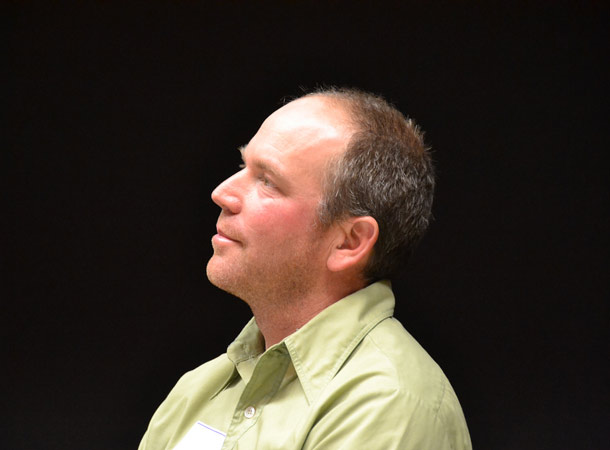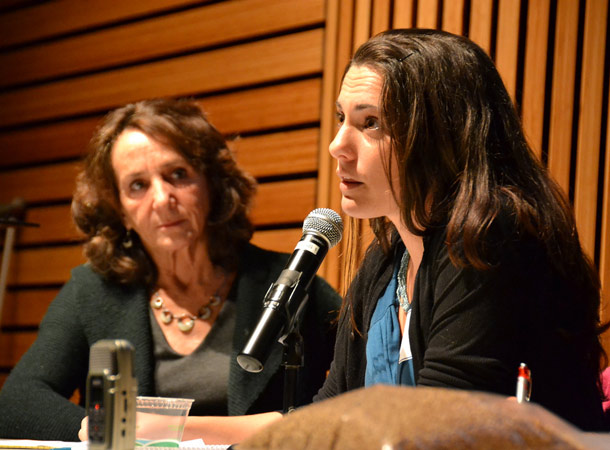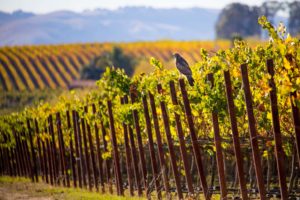On Wednesday night, November 16, a sold-out audience of 180 people filled the theater at the David Brower Center to hear from people running farming and farm-education enterprises from the San Mateo Coast to San Francisco, West Marin, and Santa Rosa.
The event, “From Urban Gardens to Urban Range,” was cosponsored by Bay Nature, Sustainable Agriculture Education (SAGE), and the Bay Area Open Space Council.
Here are some highlights from several of the panelists:
Sibella Kraus, Sustainable Agriculture Education (SAGE)
What we’re all concerned about really goes beyond local food. We care about the places food comes from and we care about local producers. We really need to go a bit deeper. When we look at the local foodshed concept, we start looking at the resources that produce the food rather than just focusing on the bounty, on the food itself.
As we do this, we see that it doesn’t always look so bountiful. Several farmers have told me that this year has been one of the hardest years in decades, with the late spring rains. So we need to think beyond the bounty and think of the stewardship piece and go to a deeper sense of responsibility, in the bear years as well as the bull years.
But in the meantime, I suggest you go out and occupy your local foodshed. You don’t have to take a tent, but some farmers would welcome you to take a tent. But just go out by the day and explore some of the food landscapes that maybe you haven’t heard about before, whether the community garden down the street or the 3,000-acre McCormack Ranch.
Magdalena Ridley, LandPaths/Bayer Farm
- Magdalena Ridley (right) and Sibella Kraus at a November 16 forum about local food production. Photo by Annie Burke, Bay Area Open Space Council.
It’s no secret that the conservation movement is desperately nondiverse, so Landpaths looked for how they could connect with a younger population, a less-affluent population, people of color.
But we don’t dictate what happens. I am a facilitator, working as a community member to say what our community would respond to. What this really is is investing socially, bringing in resources in a way that’s respectful. It was a tremendous investment into our neighborhood. This offers a level agency and sense of access that we have never had before.
The beauty and the magic we see at Bayer Farm is not because we went in and taught people what to do. We are bringing out the talents in the community. What we are doing is giving the space so that those talents can shine.
[Check out our Bayer Farm video!]
Jason Mark, Allemany Farm
I am very proud of the work we do on food production and we produce several tons of local, organic food–but it’s angels dancing on the head of the pin if you think of the amount of food consumed every day in the city and county of San Francisco.
What we’re doing is boosting food sovereignty. Food sovereignty goes deeper and says every community should have control over their own food – what they are going to plant, how they are going to plant it, how are they going to distribute it, and they should have the means to do so.
One of our biggest challenges in doing this work is continuing racial and class divides. In general, our volunteers are younger, whiter, college-educated, and they are excited to get their hands dirty. But the farm’s nearest neighbors are largely people of color, very high unemployment, and the challenge is how do we get those two groups of people to connect?
That’s the work we’re trying to do in our little part of the foodscape. When we see the streams totally connect, it will be a hugely powerful force, one that will shake the world, if only because even the 1 percent has to eat.

- Jered Lawson, of Pie Ranch on the San Mateo Coast. Photo by Annie Burke, Bay Area Open Space Council.
Jered Lawson, Pie Ranch
I feel like a lot of folks who are coming from a history of being schooled away from handwork, that we all kind of long for that practical, tangible activity where you can see the results of your work. There’s no greater joy than having that come through the production of good food that you share with people you love.
It’s exciting to see this beginning of a stronger regional emergence of the open space community really embracing the work on sustainable agriculture and food systems, the social change work. For some reason, over the last three decades, it’s been a little bit more separate. But we have a lot to celebrate in bringing our work together.
Sue Conley, Cowgirl Creamery and president of the Marin Agricultural Land Trust
[Due to a technical problem, we were unable to record Sue Conley’s remarks. What follows is a summary. –Ed.]
A cofounder of Cowgirl Creamery, Sue recounted how, when they started, they were only the second cheese maker in Marin County. Now, in Marin and Sonoma there are more than two dozen, all shown on a Cheese Trail map.
Sue discussed the long history of work by the Marin Agricultural Land Trust and others in Marin to bring together environmental and agricultural interests, and now they have good working relationships with the Resource Conservation District, Farm Bureau, UC Extension, and other agencies.
Cowgirl has grown into a sizable operation, with 100 employees and multiple retails shops–year-round jobs at good wages: “We’re not just creating jobs. We’re creating careers.”
This forum was part of the Bay Area Food Landscapes project, which included a map of all food-producing lands in the Bay Area. Learn more>
The event was supported by the Michael Lee Environmental Foundation, Clif Bar, Mary’s Gone Crackers, Wells Fargo Foundation, Farmland LP, Gather Restaurant, Center for Urban Education about Sustainable Agriculture (CUESA), Edible East Bay, Hub Bay Area, Santa Clara Food System Alliance, Slow Money, Dashe Cellars, Paradigm Winery, and Trumer Brauerei.

.jpg)




